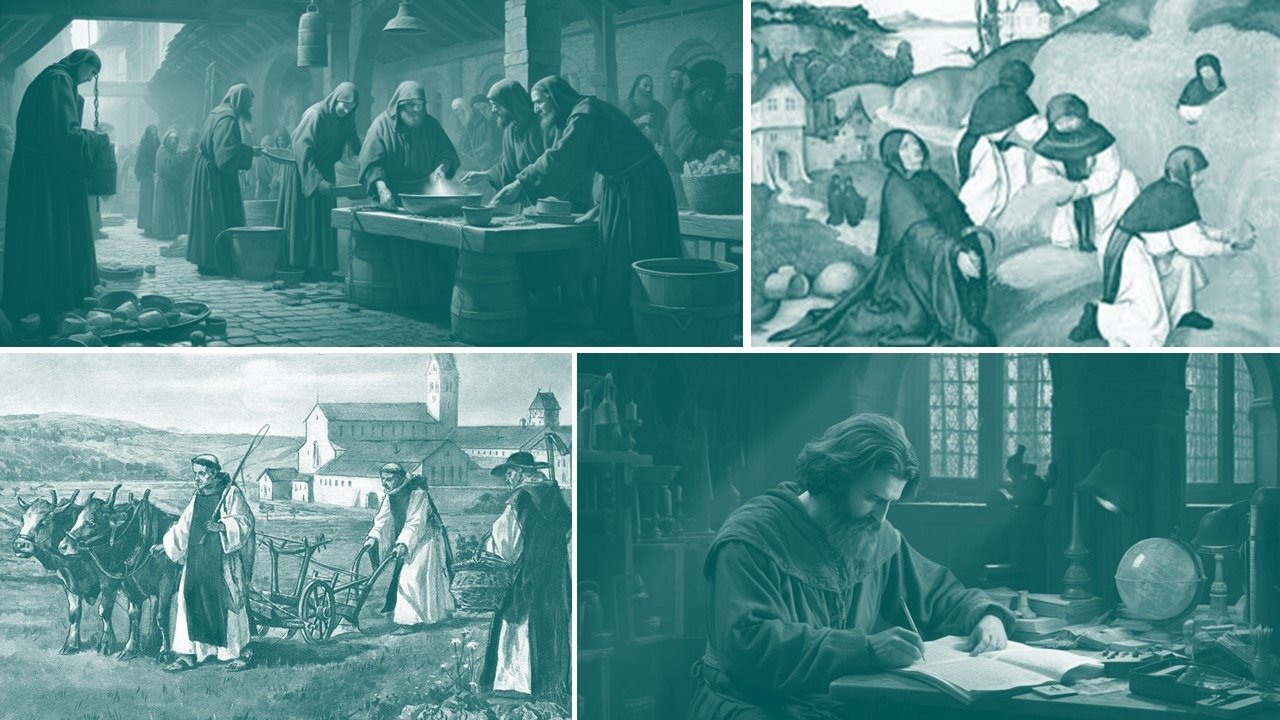
Medieval Monastic Orders - models of communal union
Rooted in the principles of Early Christian communities that followed the doctrine of “holding all things in common”, the medieval monastic orders stand as enduring examples of how shared resources and collective toiling can create thriving, harmonious common purse collaborative living associations. By integrating principles of ‘common’ wealth, Right Livelihood, and sustainable agriculture, communitarian Communal Unions can draw from this rich heritage to build a future where life, liberty, and happiness are brought to fruition and shared by all.
These lessons remind us that the pursuit of communal well-being is both a moral and practical endeavor, embedded in the timeless wisdom of working together for the common good.
The medieval monastic orders were exemplary expressions of communal living, embodying principles that resonate strongly with modern Communitarian Communal Unions. These orders practiced common purse income, expense and resource sharing, collective toiling, and resource distribution (according to need), providing a framework for sustainable living and Right Livelihood collective clean-green food, as well as artisan natural fibre clothing and durable furniture production.
The Monastic Ideal: 'common' wealth & communal living
Monastic orders such as the Benedictines, Cistercians, and Franciscans were founded on the principle of collective responsibility and shared resources. Members renounced personal wealth to live according to a common rule, ensuring that the community’s needs were met through mutual effort. This practice of pooling resources into a common purse exemplified the concept of “common” wealth that communitarian communal unions strive to replicate.
The Rule of St. Benedict, one of the most influential monastic guidelines, explicitly emphasized communal living:
“No one is to pursue what they judge better for themselves, but instead, what they judge better for someone else.” (Rule of St. Benedict, Chapter 72)
By prioritizing the collective good over individual gain, monastic communities became self-sustaining hubs of personal, social and material abundance.
Right Livelihood: Balancing Productive Work, Personal Development & Contemplation
Medieval monasticism upheld the idea that toiling was not merely a means of survival but a spiritual practice. Monks and nuns engaged in a variety of trades, including beekeeping, winemaking, and manuscript production, alongside their agricultural work. This integration of practical toiling and spiritual purpose aligns with the communitarian principle of Right Livelihood and also daily contemplation and unity with the earthly elements of earth, water, air, fire, wood and minerals & metals, along with appreciating the life-giving cosmic gifts of sun, moon and stars.
Right Livelihood within communitarian communal unions seeks to create environments where physical toil nourishes both body and mind as well as capacity for social relating. By drawing inspiration from monastic traditions, modern communities can structure labour in ways that support collective well-being while fostering personal progression and productivity together with ethical integrity.
Gardening and Collective Food Production
Monastic communities were pioneers in sustainable agriculture, integrating gardening and collective food production into their daily lives. They cultivated fields, orchards, and gardens to supply food not only for themselves but also for the poor and travellers.
The Cistercians, for example, were renowned for transforming barren lands into thriving agricultural centers. Their innovative farming techniques, such as crop rotation and water management, exemplify the potential of collective toiling to enhance productivity and environmental stewardship.
For communitarian communal unions, these practices underscore the value of gardening as a form of Right Livelihood that centred on work that sustained both the individual and the community while aligning with ethical socio-economic principles. Gardening fosters a sense of interconnectedness with the earth and each other, mirroring the monastic commitment to harmony and sustainability.
Lessons for Modern Communitarian Movements
The medieval monastic orders offer valuable lessons for contemporary efforts to build equitable and sustainable communities:
- Common Purse Systems: Like the monasteries, Communitarian Communal Unions can adopt common wealth provisioning to ensure that resources are shared equitably.
- Gardening and Food Sovereignty: Collective gardening provides not only sustenance but also a means to reconnect with the earth and build resilience against external economic pressures.
- Work-Life Balance: The monastic rhythm of work, prayer, and rest demonstrates the importance of balancing productivity with reflection and communal connection.
